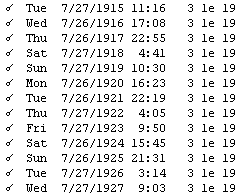
| What Watch? - Tutorial | Next chapter: Atlas and Time Zones | Back to First Page |
Solar Return and Persona charts
Solar Return charts can easily be drawn in What Watch using the features described in the past chapters of this tutorial. Basically, a Solar Return is a conjunction of transiting and natal Sun. Use the transit module to create a list of all Sun/Sun conjunctions for your chart: there is already a pre-defined shortcut available – the "solar return" button in the top panel of What Watch.
This technique works with any planet: As an example, choose Saturn as birth planet and as transiting planet, and press "List". This is how you can analyze Saturn cycles. Lunar Returns are another useful example.
In the resulting list, pick the aspect for the year you're interested in. Right click on the line, and the corresponding horoscope is drawn in Wheel Two if you're working on horoscope One, and in Wheel One if you're working on horoscope Two.
 |
If on your birthday you've been away from your place of birth, you need to relocate your chart. In the Geography module, shift click on the place on the globe that you've been to during the time of the Solar return. Use the left mouse button to relocate chart One, the right button changes chart Two. Use synastry to have a combined view of the natal and return charts. The list on the left shows Solar Returns for Carl Gustav Jung. Take as an example the year 1921: you'll find the Moon on the Ascendant and Pluto on the IC. Promising. |
Persona charts can be calculated in the same way. Select any birth planet you like and the Sun as transiting planet. In the resulting list, choose the first conjunction after birth, right click on the line – here is your persona chart.
You can also apply this technique to find out the New Moon before birth. Change to "Mundane" mode, select the Sun as slower and the Moon as faster planet and press "List". In the resulting list, choose the last conjunction before birth, right click on the line – this is the chart for the New Moon before birth. Again, use synastry to have a combined view of the natal and the New Moon chart.
| What Watch? - Tutorial | Next chapter: Atlas and Time Zones | Back to First Page |